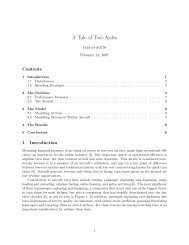Neural Models of Bayesian Belief Propagation Rajesh ... - Washington
Neural Models of Bayesian Belief Propagation Rajesh ... - Washington
Neural Models of Bayesian Belief Propagation Rajesh ... - Washington
Create successful ePaper yourself
Turn your PDF publications into a flip-book with our unique Google optimized e-Paper software.
256 11 <strong>Neural</strong> <strong>Models</strong> <strong>of</strong> <strong>Bayesian</strong> <strong>Belief</strong> <strong>Propagation</strong> <strong>Rajesh</strong> P. N. Rao<br />
inference method known as particle filtering. The model is similar to our approach<br />
in that inference involves message passing between different levels, but<br />
whereas the particle-filtering method assumes continuous random variables,<br />
our approach uses discrete random variables. The latter choice allows a concrete<br />
model for neural representation and processing <strong>of</strong> probabilities, while it<br />
is unclear how a biologically plausible network <strong>of</strong> neurons can implement the<br />
different components <strong>of</strong> the particle filtering algorithm.<br />
The hierarchical model for attention described in section 11.4.3 bears some<br />
similarities to a recent <strong>Bayesian</strong> model proposed by Yu and Dayan [47] (see<br />
also [7, 32]). Yu and Dayan use a five-layer neural architecture and a log probability<br />
encoding scheme as in [30] to model reaction time effects and multiplicative<br />
response modulation. Their model, however, does not use an intermediate<br />
representation to factor input images into separate feature and location<br />
attributes. It therefore cannot explain effects such as the influence <strong>of</strong> attention<br />
on neighboring unattended locations [4]. A number <strong>of</strong> other neural models<br />
exist for attention, e.g., models by Grossberg and colleagues [13, 14], that are<br />
much more detailed in specifying how various components <strong>of</strong> the model fit<br />
with cortical architecture and circuitry. The approach presented in this chapter<br />
may be viewed as a first step toward bridging the gap between detailed neural<br />
models and more abstract <strong>Bayesian</strong> theories <strong>of</strong> perception.<br />
11.5.2 Open Problems and Future Challenges<br />
An important open problem not addressed in this chapter is learning and adaptation.<br />
How are the various conditional probability distributions in a graphical<br />
model learned by a network implementing <strong>Bayesian</strong> inference? For instance,<br />
in the case <strong>of</strong> the HMM model used in section 11.4.1, how can the transition<br />
probabilities between states from one time step to the next be learned? Can<br />
well-known biologically plausible learning rules such as Hebbian learning or<br />
the Bienenstock-Cooper-Munro (BCM) rule (e.g., see [5]) be used to learn conditional<br />
probabilities? What are the implications <strong>of</strong> spike-timing dependent<br />
plasticity (STDP) and short-term plasticity on probabilistic representations in<br />
neural populations?<br />
A second open question is the use <strong>of</strong> spikes in probabilistic representations.<br />
The models described above were based directly or indirectly on instantaneous<br />
firing rates. Even the noisy spiking model proposed in section 11.3.3 can be<br />
regarded as encoding posterior probabilities in terms <strong>of</strong> instantaneous firing<br />
rates. Spikes in this model are used only as a mechanism for communicating<br />
information about firing rate over long distances. An intriguing alternate<br />
possibility that is worth exploring is whether probability distributions can be<br />
encoded using spike timing-based codes. Such codes may be intimately linked<br />
to timing-based learning mechanisms such as STDP.<br />
Another interesting issue is how the dendritic nonlinearities known to exist<br />
in cortical neurons could be exploited to implement belief propagation as in<br />
equation (11.19). This could be studied systematically with a biophysical compartmental<br />
model <strong>of</strong> a cortical neuron by varying the distribution and densities
















